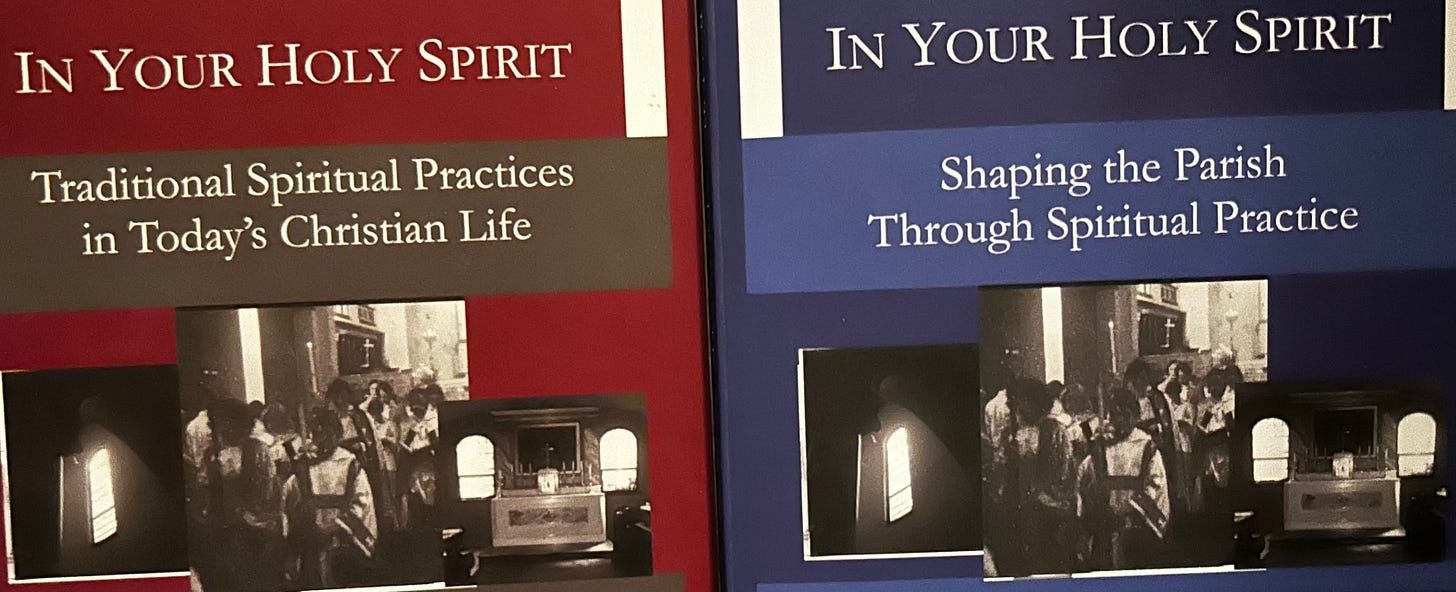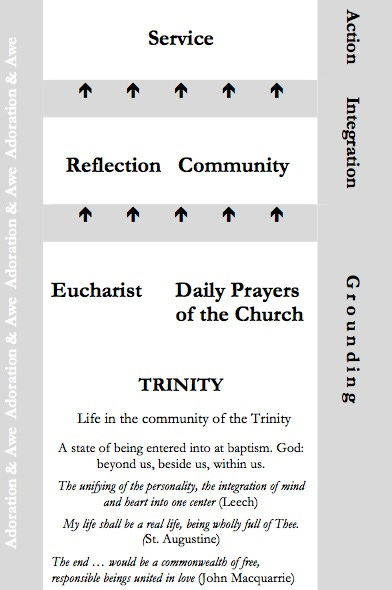A resource for adult formation. We begin with the Introduction to Sister Michelle’s In Your Holy Spirit: Traditional Spiritual Practices in Today's Christian Life, That’s followed by a set of resources you can use in the parish.
Give them an inquiring and discerning heart, the courage to will and to persevere, a spirit to know and to love you, and the gift of joy and wonder in all your works. (BCP)
“The prayer above is the one offered after a person is baptized with water and before the sealing with oil. This prayer provides a glimpse into what we can become as we grow into our baptismal identity. In this book, we hope to provide ways in which individual Christians can approach their spiritual lives, to help deepen and further develop them, and to take greater adult responsibility for that development.
We will offer some theory, some images, but mainly we will offer concrete ways in which individuals can enter into the mystery of the holy and better integrate their experience of daily life with the sacred. We have written two companion books addressing spiritual practices. Michelle Heyne, working with input from Bob Gallagher, has written about spiritual practices from the perspective of the laity. Bob Gallagher, working with input from Michelle, has written about how the parish church and its clergy can better support and foster the development of spiritual life and practices. Both use the same map of spiritual practice.
The spiritual map
The “map” we are offering includes five elements. At the base there are two practices—one weekly, one daily. That rhythm is common to many religious and spiritual traditions. These elements have to do with living in the habits and ways that keep us grounded in what is most real. In Anglicanism they take form as the Holy Eucharist (Mass, Communion) and the Daily Office (Divine Office, Liturgy of the Hours, Daily Prayer of the Church).
There are two more elements standing side by side on that base— base—Community and Reflection. Our assumption is that we are all called to be part of not just the broader human and national communities but also of particular, imperfect communities that we allow to nurture and influence us. In Anglicanism, that includes the parish church. Reflection includes developing our capacity to be silent and still, to listen to our life, and to learn from our experience. Reflection is about connecting our internal life to the life of God.
The final element is Service. We are all called to serve in ways that fit our gifts and temperament. That service may be most fruitful, for others and for us, when it sits upon the base of the other four spiritual practices.”
Perspective and Approach
“I write this as a devout Episcopalian living in Seattle, Washington. I am intellectually oriented, socially liberal, a feminist, and a Christian deeply committed to the traditional expression of faith found in the Anglican Church. The Northwest is frequently cited as being profoundly “unchurched,” and indeed, few of my friends or even family members are involved with any form of organized religion. At the same time, the Northwest is known as a place of pervasive and extensive spirituality, where, for example, self-identification as “spiritual but not religious” is an absolute must when signing up with online dating services or when complaining about the latest excesses of the religious right. As a person who considers herself both spiritual and religious, I am aware of how unusual that idea has become in many circles. “Spirituality” is a big word and it can mean pretty much anything you want it to. In writing this, I am most drawn to Henri Nouwen’s statement that “the spiritual life is a reaching out to our innermost self, to our fellow human beings and to our God.” Spirituality is often, but not always, grounded in a specific religious tradition that concretizes the meaning, form, and content of those forms of “reaching out.” Religion and its institutions, its communities, ties, traditions, and ways of being, provide us with a structure that can facilitate the transformation of spiritual longing into action. The further we wander from the traditional spiritual disciplines of the church and its norms around Eucharist, common prayer, and community life, the more likely we are to nurture the sinfulness, egocentricism, and abuse of power that flourish in human institutions. Fights and schisms tend to erupt in response to conflicting understandings of spiritual health, of sin, and of the worthiness of others. Conflict over these issues that grows out of a shared spiritual practice can be quite different from conflicts that arise from our independent assessment of them from a stance of outsider, owner, or arbiter. I like to imagine that we can see ourselves instead as members of the Body of Christ. Norms, structures, and community life—the content and pattern of our spiritual discipline—all require us to come up against something outside ourselves that is presumed valuable and then decide how to respond to the challenge. Are we absorbed into the machine? Do we fight it? Do we pick and choose, ignoring what we dislike, embracing what we do like? Do we chuck the whole thing whenever it becomes uncomfortable, or even infuriating?
The transformation occurs when we accept that we are members of the Body of Christ, and we recognize that the Body is not separate from its members but neither is it the sum of its parts. My own life has been shaped by the Anglican tradition and, most important, by Anglican worship in community, and I write from that perspective. Religious affiliation is not a mere preference; rather, it is deeply connected to who we are as human beings and how each of us can best enter into a relationship with the divine and be transformed by that relationship. That emphatically does not mean that those who take a different path are wrong or misguided, but it also doesn’t mean that every path is equally valid or equally useful. Many of the practices we will explore in this book have a long history in the Catholic churches and variations are commonly found in Protestant denominations, as well as in other faiths. They do not belong solely to one branch of the church, but they may have a particular flavor or expression depending on the religious community they come out of. Much of what we will talk about can be usefully adapted to a wide range of denominations and worship styles. Examples include the importance of choosing to participate and take responsibility for your own spiritual life, the use of silence in worship, the importance of reflection, how we participate in community, and the nature of Christian service. Some of the specific liturgical actions or administrative structures we describe may be most common in the Episcopal Church, but the underlying ideas are foundational to Christian practice. While less liturgical traditions will not, for example, have the same experience of Eucharist or Daily Office described in this book, I do think it’s worthwhile to consider the nature of worship whatever one’s tradition. How does it feed you? How does it aid your encounter with the living God? How does it help you grow up in Christ? This book may offer you approaches or perspectives useful in terms of your stance toward worship and your own internal sense of how you will get what you need, regardless of the form that worship takes around you.(Introduction,” In Your Holy Spirit: Traditional Spiritual Practices in Today's Christian Life, Michelle Heyne, OA, 2011.)
Here are related resources
Books on that model
In Your Holy Spirit: Traditional Spiritual Practices in Today’s Christian Life, Michelle Heyne. AMAZON
In Your Holy Spirit: Shaping the Parish Through Spiritual Practice, Robert Gallagher. AMAZON
PDF handout
Assessing the Parish's Spiritual Practices - In Your Holy Spirit Model
Assessing Your Spiritual Practices - For individuals, In Your Holy Spirit model
Related reading
Five session spiritual assessment, chapter 2, Nothing so contagious as holiness: Developmental Initiatives for Increased Parish Vitality Grounded in Spiritual Practice AMAZON
The group process Sister Michelle has used in many parishes
1. Identify 5 stations in the room - Eucharist, Daily Office, Community, Reflection, Service. Mark each in some manner
2. Introduce the model in broad terms
3. Ask people to go to the place in which they have experienced as the most important in their spiritual life. Have them talk in the groups that form - briefly share why they selected that group
4. Ask them to move to the second most important - share
5. Ask them to go to the spiritual practice that they find most challenging for them. Share what it might be like if they experimented with that practice.
This abides,
Sister Michelle, OA & Brother Robert, OA





